Posted by Benjamin Hunting Know How
A seized lug nut can turn the simple task of changing a tire into a frustrating experience. It doesn’t have to be that way — there are a number of tricks on how to loosen a nut that just won’t budge, so you can get the job done and get back on the road. Let’s look at the basic steps you should go through when dealing with a stuck lug nut.
1. Soak ItMost of the time, a seized lug nut won’t lighten its grip due to corrosion, which happens when water, road salt and oxygen mix where the threads meet. It can also occur at the base of the nut, cementing it in place.
The least labor-intensive way to break a rusty lug nut free is by soaking it in a product like WD-40, PB Blaster or some other oil-based lubricant. Spray it at the base of the nut and wait, as long as you can, for the oil to work its way through the threads and between the nut and the metal of your hub.
If you can, try leaving it overnight.
If your socket isn’t tight enough, it won’t be able to properly grip and turn the seized lug nut. In fact, a loose socket is more likely to spin around the nut and round off its edges, creating a second problem for you to deal with. Ensure that the socket you are using is the right size, and that it’s on as tight as possible before applying torque.
3. Mechanical AdvantageYou can increase the amount of torque by lengthening the arm of the driver used to spin the socket. Use as long of a driver handle as you can, and then fit a piece of hollow piping over the handle to further extend the arc. This can add two to three times as much torque to that initial turning action, which is often what is needed to break the lug nut loose. You can also hammer it, or jump down on the bar (as long as it’s tightly secured), to add extra turning force.
Avoid Power ToolsWhile it might be tempting to use an impact wrench to remove a seized lug nut, it’s not the best idea. More often than not, an impact driver will simply round off the nut rather than break it free if it’s really stuck. The above steps — combined with patience and time — are the best options for easy lug nut removal.
More often than not, an impact driver will simply round off the nut rather than break it free if it’s really stuck. The above steps — combined with patience and time — are the best options for easy lug nut removal.
Check out all the tire and wheel products available on NAPA Online or trust one of our 17,000 NAPA AutoCare locations for routine maintenance and repairs. For more information on dealing with a seized lug nut, chat with a knowledgeable expert at your local NAPA AUTO PARTS store.
Photo courtesy of Creative Commons.
Categories
Know How
Tags
hardware, lug nut, lug nut remover, nut, removing rusted nuts and bolts, rust, wheel stud, wheels
Having been bitten by the car bug at a young age, I spent my formative years surrounded by Studebakers at car shows across Quebec and the northeastern United States. Over ten years of racing, restoring, and obsessing over automobiles lead me to balance science writing and automotive journalism full time. I currently contribute as an editor to several online and print automotive publications, and I also write and consult for the pharmaceutical and medical device industry.
I currently contribute as an editor to several online and print automotive publications, and I also write and consult for the pharmaceutical and medical device industry.
by Ron Coddington
Note: This post may contain affiliate links. This means we may earn a small commission for qualifying purchases at no cost to you.
35 shares
Last Updated on May 5, 2022
If you drive a conventional car, it will likely have five lug nuts (or bolts) at each wheel (some models only have four). These twenty fasteners could be the most important ones on your entire car. That’s because if five of them on any wheel break or come off while you’re driving, you will most assuredly have an extremely troubling experience.
Happily, the scenario I have described is extremely rare. And that is a credit to the automotive engineers who design these fasteners and how they are used to attach your wheels. A big piece of the designing of these fasteners includes making them some of the strongest nuts and bolts on your car.
A big piece of the designing of these fasteners includes making them some of the strongest nuts and bolts on your car.
Need help with a car problem RIGHT NOW?
Click Here to chat online with a verified mechanic who will answer your questions.
Sometimes, however, when a flat tire occurs or you just want to rotate the tires, a lug nut will have seized and cannot be removed. It just won’t budge. And on rare occasions, the lug nut is rusted and this corrosion makes removal nearly impossible.
In other cases, surface damage allows the flats on the lug nut to round off as you struggle to remove it. In this article we will discuss what you can do to resolve these problems.
Important
Before beginning this project, please review the important safety tips for working on your car in this article.
Table of Contents
We’re going to focus on problems with conventional lug nuts screwed on to wheel studs. However, several brands of European cars use lug bolts which screw into the wheel hub. BMW, Audi and Volkswagen are examples.
However, several brands of European cars use lug bolts which screw into the wheel hub. BMW, Audi and Volkswagen are examples.
Some of the techniques discussed here can work for lug bolts as well. This will be noted in the appropriate sections.
Related: Lug Nut Sizes and Types (w/ Charts for Most Car Manufacturers)
The following are three common causes for a wheel lug nut refusing to come off. The lug nut or bolt may be:
In this case, use of an impact wrench or wrong size socket while installing a lug nut or bolt has rounded off (stripped) the hex-shape of the fastener. Or maybe it’s seized and your attempts to remove it with a lug wrench or socket have rounded it off.
In either case the fastener cannot be gripped such that it can be removed.
Read Also: What’s the Purpose of Wheel Spikes?
A zealous mechanic armed with an impact wrench may have over tightened one of the lug nuts on your car. Now it’s seized. It cannot be removed using the lug wrench that’s packed with your spare tire.
Now it’s seized. It cannot be removed using the lug wrench that’s packed with your spare tire.
Note: Prior to purchasing new tires, confirm that the tire shop you've selected always uses a torque wrench when installing the wheels. Proper use of a torque wrench ensures that each wheel fastener is not under or over tightened.
The lug nuts and studs or bolts are severely rusted. This is common on older cars and cars that have been left unattended and uncovered in outdoor weather for many months. In this condition, the fastener also may be seized and just won’t turn.
Related: 5 Ways to Remove a Stubborn Bolt
Whether the lug nut is stripped, rounded-off, or seized due to either over tightening or corrosion, the loosening process will typically be the same except as noted below.
Begin with your car on the ground; not on jack stands or lifted up in any way. Make sure the transmission is set to Park or it’s in gear and firmly set the emergency brake. These steps will keep the wheels from rotating as you attempt to loosen the fasteners.
These steps will keep the wheels from rotating as you attempt to loosen the fasteners.
Note: This step covers the rusted nut or bolt. If the fastener is seized or its head is stripped, proceed to Step 2.
First, the nut and stud must be soaked with a penetrating oil. If the nut has a closed head, drilling that head can help get the oil into the threads.
To do this you will need high quality drill bits such as cobalt alloy steel drills in 5/64″ and 7/64″ diameters.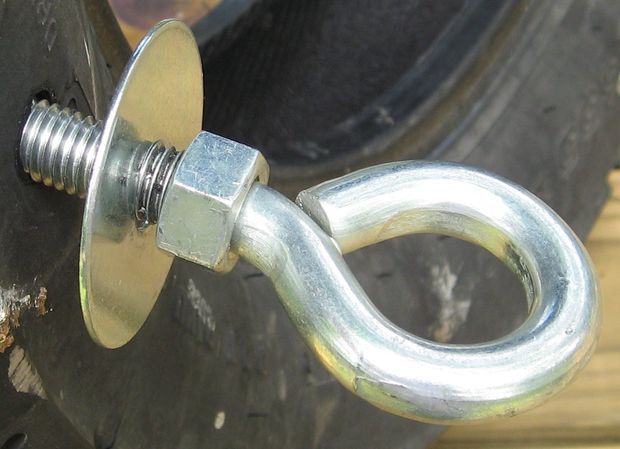 Buy two of each since these small drills are very easy to break.
Buy two of each since these small drills are very easy to break.
Drilling will be benefitted by the use of a lubricant. Three-in-One oil or equivalent will be adequate for this job. Also have a cup of cool water nearby. Now put on your safety glasses. Use a center punch and hammer to dimple the center of the lug nut.
Begin drilling with the smaller drill bit. Wet the tip of the bit with oil. Steady the drill motor with two hands. Drill at a very slow speed. Be careful to not bend the drill bit; this will break it pretty quickly.
Frequently stop drilling especially if the oil begins to smoke. Dip the hot bit in the water to cool it. Wipe away chips and reapply oil to the bit and hole. Repeat this process until the bit breaks through to the top of the stud.
Install the 7/64″ bit in the drill motor and repeat the above drilling procedure. Hold the drill motor firmly because the bit may want to suddenly grab in the hole and rotate the drill. Drill through again to the top of the stud.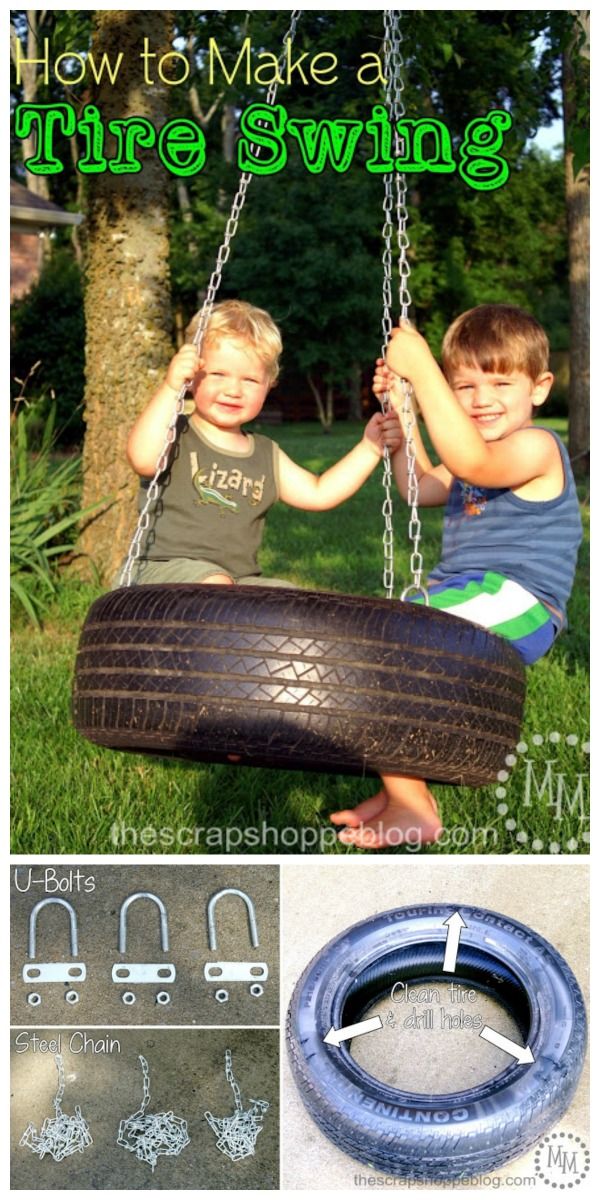
You now have access to a reservoir for soaking the nut and stud with WD-40 or equivalent. Insert the WD-40 tube into the hole and wrap the tube at the nut surface with a shop (or paper) towel to catch any back spray. Squirt a bit of this lube into the hole.
Also spray WD-40 around the base of the lug nut. If time permits, allow the penetrating lube to soak overnight. It will then be more effective in freeing up the nut. Next morning add another squirt to the hole and base of the nut.
Corroded lug bolts will not benefit from the use of WD-40. With the wheel installed, the lug bolt threads are virtually inaccessible.
See Also: How to Remove a Stripped Oil Drain Plug
Select a 1/2″ drive 6 point socket that fits snugly on the nut or bolt. A deep socket may be required. A severely rusted fastener may be worn down such that a one size smaller socket (or smaller SAE equivalent for a metric lug nut; or smaller metric equivalent for an SAE lug nut) can be tapped on with a hammer.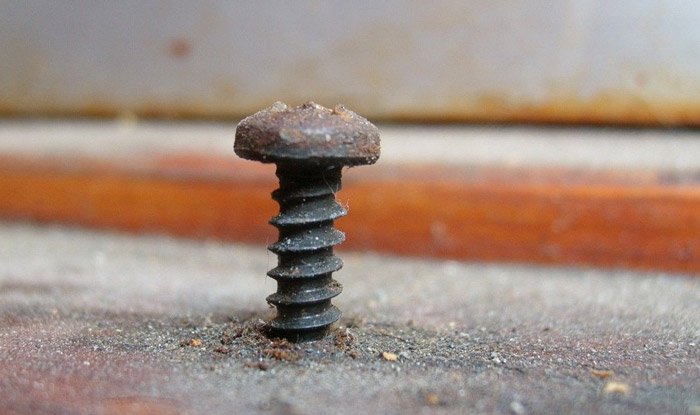
Sometimes a one size smaller 12 point socket will tap into the rusted hex shape and grip pretty well.
If the nut or bolt head will not receive a conventional socket or is worn to a rounded shape, use of an extractor socket may be necessary. A suitable lug nut extractor set such as one by Irwin (best) or ABN (good) can be purchased online or at a quality auto parts store.
Use a socket size that is snug on the hex shape and hammer it in place. Using a short hardwood dowel against the socket while hammering can help you avoid striking your costly alloy wheel.
Use a 1/2″ drive breaker bar that’s ideally 18″ to 24″ in length. Install it into the socket so that the handle extends horizontally and is in the position to be lifted upward to loosen the nut (if using a floor jack) or pushed downward (if not using a floor jack).
Place your floor jack under the breaker bar handle and pump it up to lift the handle.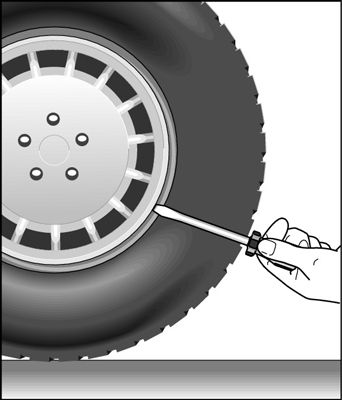 You can generate up to one quarter of your car’s weight in pounds of force using this technique. Do keep your distance as the bar will bend and want to spring off the lug nut or off the lift pad of the floor jack.
You can generate up to one quarter of your car’s weight in pounds of force using this technique. Do keep your distance as the bar will bend and want to spring off the lug nut or off the lift pad of the floor jack.
Relate: How to Use a Hydraulic Floor Jack
If you have no suitable floor jack, you can apply considerable force to the breaker bar by sliding a pipe over the bar handle. The pipe should be slightly larger than the breaker bar to fit snugly. A three foot long pipe will work well for this.
Position the breaker bar so it is at an upward angle of about 10 degrees and to the left of the nut. You will be pushing downward to loosen the nut. Use your weight to apply force by carefully stepping onto the pipe.
Hold onto the side of your car to steady yourself. Use extreme caution to avoid slipping off the pipe or falling should the bar and socket pop off the lug nut or the nut suddenly break free.
You can reverse the bar position so that you must lift the pipe to turn the lug nut.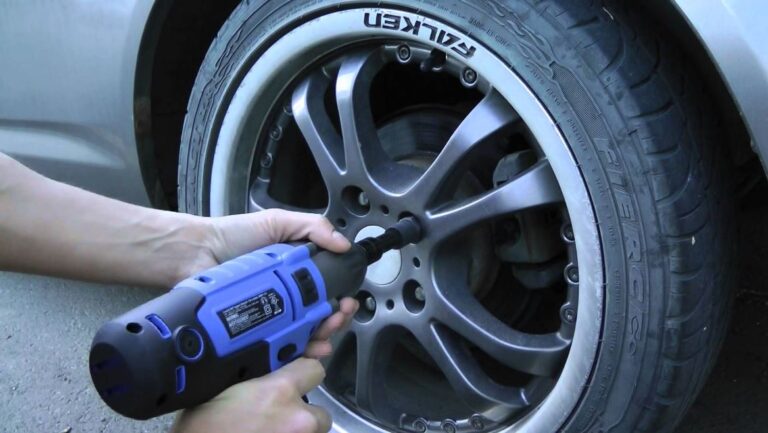 Put on a pair of leather gloves to improve your grip. Note that lifting this way can be hard on your back so don’t overdo it. Also the pipe may bend so be cautious about the socket popping off the lug nut.
Put on a pair of leather gloves to improve your grip. Note that lifting this way can be hard on your back so don’t overdo it. Also the pipe may bend so be cautious about the socket popping off the lug nut.
Loosen the other lug nuts. Now you can jack the car up, properly support it and remove all the fasteners and then the wheel. Safe jacking procedures can be found HERE.
On rare occasion, the above fastener removal procedure will not get a lug nut or bolt off. If this should happen, a last ditch removal procedure is possible using a tool called the Lug Ripper.
To successfully use this tool will require you to precisely follow the manufacturer’s instructions at their website. Failure to do so can damage the tool rendering it unusable.
Be aware that this toolkit is not cheap. However, purchasing it may prove less expensive than taking your car to a qualified repair or tire shop for corrective action.
After successful removal of the stuck lug nut or bolt, you may choose to resell the Lug Ripper on Ebay, Craigslist, or local marketplace to recover much of the cost.
Following the removal of a seized or rusted lug nut or bolt, you should purchase and install new fasteners for the entire bolt pattern. Replacing just the damaged fastener could result in an out-of-balance condition.
Wheel studs that had seized or rusted lug nuts should be inspected.
Any stud that displays damage and/or fails the inspection above should be replaced. If you are in any doubt about a stud’s condition, always replace it.
Categories Tires & Wheels Tags productAsk a question, get an answer ASAP!
 Effective ways to loosen stuck wheel bolts. How to unscrew the stuck bolts on the wheels of the car.
Effective ways to loosen stuck wheel bolts. How to unscrew the stuck bolts on the wheels of the car. Wheel bolts attach the car wheel to the hub and whenever you want to change tires, get access to the suspension, brakes, you have to unscrew them. The ability to unscrew the wheel is necessary for every driver, since no one is immune from punctures. Unscrewing the bolts is not at all difficult, but if they have not been touched for a long time, they can rust. Our article will help to cope with such a problem. 9Ol000
To prevent the vehicle from rolling away, place it on a level surface and apply the parking brake.
 In this case, it is necessary to dismantle the cap to gain access to the bolts. Protective caps can be fastened with bolts, metal clips or other plastic fasteners.
In this case, it is necessary to dismantle the cap to gain access to the bolts. Protective caps can be fastened with bolts, metal clips or other plastic fasteners.  The bolts must be loosened while the vehicle is on the ground with all wheels. Do not jack up the machine until the bolts are loosened.
The bolts must be loosened while the vehicle is on the ground with all wheels. Do not jack up the machine until the bolts are loosened.
Check that the machine is on the handbrake. If the bolts stick, it will take a lot of force, so make sure the vehicle will not move.
Often, wheel wrenches have a short handle, which does not allow you to develop sufficient force. The easiest and safest way is to extend the handle of your key. This will make it possible to create a very significant effort. In the absence of a wrench with a long handle, you need to put a metal pipe on the handle of your wrench.
If your arms aren't strong enough to loosen bolts, use the strongest muscle in your body, your legs. To do this, put the wrench on the nut so that the handle is parallel to the ground. Carefully place one foot on the key so that it spins counterclockwise. You can also lean on the car with your hands and stand on the key with both feet. Then jump a little. When the nut has moved, unscrew it as usual. Be very careful. The key is not the trampoline. You can not kick the key or jump on it so that the feet come off the handle. Avoid sudden loads on the key.
To do this, put the wrench on the nut so that the handle is parallel to the ground. Carefully place one foot on the key so that it spins counterclockwise. You can also lean on the car with your hands and stand on the key with both feet. Then jump a little. When the nut has moved, unscrew it as usual. Be very careful. The key is not the trampoline. You can not kick the key or jump on it so that the feet come off the handle. Avoid sudden loads on the key.
Take a hammer or mallet and hit the handle of the wrench, in some cases this is great for loosening stuck nuts. In extreme cases, even a stone can be used instead of a hammer. Avoid slipping as the bolt and wrench may be damaged. It is necessary to apply short well-aimed blows.
Use a torque wrench when tightening bolts. If the wheel bolts on your vehicle are too tight after the last removal of the wheels, use a torque wrench to secure the wheels to the torque recommended in the manual.
Chemicals should only be used as a last resort. If the bolts are overtight, apply Liquid Wrench or PB Blaster to the bolt. To apply the product exactly on the bolt, use a watering can with a thin spout. Wait ten minutes and try to unscrew.
Lubricant on the brake disc can increase braking distance and cause an accident. If liquid gets on the disc, clean it with a solvent and a clean rag. If oil gets on the pads, you will have to replace them.
If the car's wheel is stuck to the hub, loosen the bolts and try driving the car for a short distance. This force will pull the wheel off the hub.
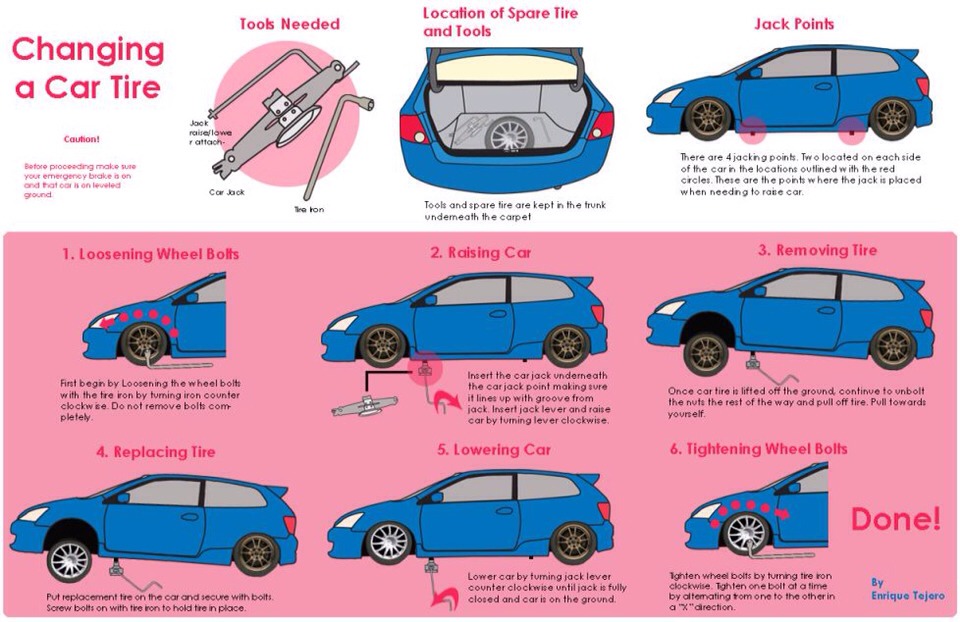 How to put up a jack. Types of jacks for cars.
How to put up a jack. Types of jacks for cars.  Peugeot 206 rear beam malfunction, Peugeot 206 rear beam repair
Peugeot 206 rear beam malfunction, Peugeot 206 rear beam repair  Lost car key what to do, car key inside the car
Lost car key what to do, car key inside the car Photo: AvtoVzglyad
Rolled bolts and studs, "licked" edges of nuts increase the time and cost of car repairs. How to disassemble threaded connections and keep fasteners intact? The experts of the portal "AvtoVzglyad" will prompt.
How to disassemble threaded connections and keep fasteners intact? The experts of the portal "AvtoVzglyad" will prompt.
Lika Shutter
Very often repair or maintenance of a car begins with the disassembly of threaded connections. For example, when a seasonal tire change occurs. By itself, the process of unscrewing the bolts is not difficult, but only if the fasteners resist. As practice shows, during the summer season, wheel bolts and nuts can boil.
A rolled bolt, especially when its body is left in the hole, will either have to be drilled or removed with an extractor (this is such a special reverse screw that is screwed counterclockwise into a pre-drilled hole in the body of the bolt or stud), which requires a special tool , and experience. If you act ineptly, then it is quite easy to damage the threads in the well, and then you will have to correct it with the help of taps, which, again, not everyone has. Well, “dancing with tambourines”, when a steel bar is welded to a broken bolt in order to unscrew its remnants, this is generally aerobatics.
Who has a welding machine? Who can accurately and at the same time securely “grab” the details? Not only will you have to pay extra for this work, but how much time will you have to kill searching for and buying the necessary fasteners. Therefore, taking care of how to unscrew the soured fasteners so as not to damage it is worth it in advance.
Photo: AvtoVzglyad
To avoid all the problems described above, experts recommend using specialized tools that make it easier to disassemble soured fasteners and minimize the likelihood of damage. We are talking about the so-called penetrating lubricants, including all kinds of "liquid keys".
Actually, the name speaks for itself, and their main property is precisely penetrating, that is, how quickly the composition will penetrate into the joint, and it will lend itself to unscrewing. By the way, one of the best among them is the Liquid Key from Astrohim. As practice confirms, the domestic composition effectively impregnates rust, minimizing the shear moment, and it will not be necessary to “soak” soured fasteners for a long time.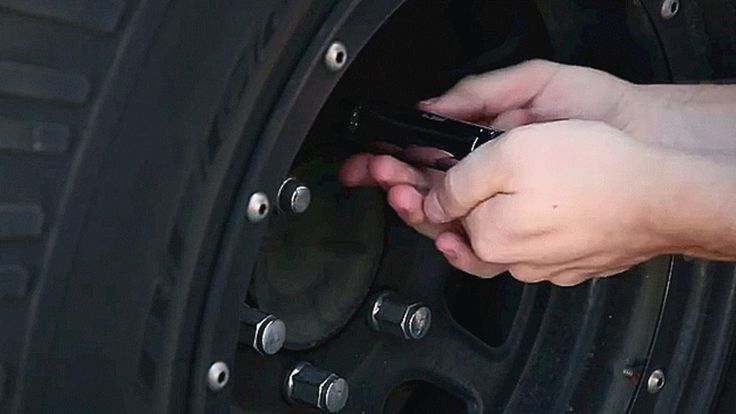
Compounds of this kind are applied directly to fasteners that have been previously cleaned of dirt and rust. After a few minutes, you can pick up tools and unscrew the fasteners, which should “go” with less effort
and, most importantly, stay safe and sound. Shamanism? — no, physics and chemistry in action!
Photo: AvtoVzglyad
The active composition, penetrating through the micropores into the gaps between the parts, delivers lubricating components there. It is they that impregnate the corrosion products and reduce the shear moment of the "stuck" elements relative to each other. But the effect is achieved only on the condition that the composition penetrates as deep as possible into the soured compound. What's the point if it wets only the surface layer of rust?!
Therefore, in order not to jump on the balloon wrench or not to use an extension (pipe), risking turning off the fasteners or loosening the stud (it can turn in the drum or hub), you can simply soak it with a “liquid wrench” and unscrew it without barbaric methods.